|
|
 |
|
Calanoida ( Order ) |
|
|
|
Diaptomoidea ( Superfamily ) |
|
|
|
Candaciidae ( Family ) |
|
|
|
Candacia ( Genus ) |
|
|
| |
Candacia armata (Boeck, 1872) (F,M) | |
| | | | | | | Syn.: | Candace armata Boeck,1872;
Candace pectinata Brady, 1878 (p.49, figs.F,M); Giesbrecht, 1892 (p.424, 439, figs.F,M); Giesbrecht & Schmeil, 1898 (p.128); Wheeler, 1901 (p.177, figs.F,M); no Esterly, 1905 (p.193, figs.F,M); ? Dakin & Colefax, 1933 (p.206, Rem.); no Mori, 1937 (1964) (p.83, figs.M); Dakin & Colefax, 1940 (p.105, figs.F,M); Sewell, 1948 (p.391, 396, 404, 408, 415, 423, 443, 457, 460, 463, 467, 470, 475, 479, 480, 482, 484, 485, 486, 490, 491); Chiba & al., 1957 a (p.11); ? Kott, 1957 (p.6, 18); ? in CalCOFI regional list (MDO, Nov. 2013; M. Ohman, pers. comm.)
Candacia pectinata : V.N. Greze, 1963 a (tabl.2); Anraku & Azeta, 1965 (p.13, Table 2, fish predator); Kovalev & Shmeleva, 1982 (p.85); Hernandez-Trujillo, 1989 a (tab.1); Suarez-Morales & Gasca, 1998 a (p109); Hernandez-Trujillo & Esqueda-Escarcega, 2002 (in Appendix); in CalCOFI regional list (MDO, Nov. 2013; M. Ohman, comm. pers.); Palomares-Garcia & al., 2018 (p.178, Table 1: not seen in La Paz Bay from 1987-2011) | | | | Ref.: | | | Giesbrecht & Schmeil, 1898 (p.130); Sars, 1902 (1903) (p.135, figs.F,M); Thompson & Scott, 1903 (p.235, 250); Sharpe, 1910 (p.413); Lysholm, 1913 (p.7); Pesta, 1920 (p.536); Sars, 1925 (p.350); Farran, 1926 (p.291); Candeias, 1926 (1929) (p.41, figs.F); Rose, 1929 (p.39); Wilson, 1932 a (p.139, figs.F,M); Rose, 1933 a (p.253, figs.F,M); Lysholm & al., 1945 (p.41); Farran, 1948 b (n°13, p.3, figs.F,M); Mazza, 1962 (p.341, figs.F,M); Crisafi, 1963 (part.., p.109, figs. M, juv.); Grice, 1963 (p.174, figs.F,M); M. Bernard, 1964 (p.58, figs.Nauplius); ? De Decker, 1964 (p.15, 18, 19, Rem.); Razouls, 1972 (p.95, Annexe: p.86, figs.F,M); Kos, 1972 (Vol. I, figs.F,M, Rem.); Grice & Lawson, 1977 (p.263, figs.F,M); Nival & Nival, 1978 (p.83, figs.F,M, Rem.: Md.); Arnaud & al., 1980 (p.213, gut structure); Sazhina, 1985 (p.67, figs.N); Schnack, 1989 (p.137, tab.1, fig.6: Md); Barthélémy & al., 1998 (p.721, genital area); Bradford-Grieve & al., 1999 (p.885, 956, figs.F,M); Barthélémy, 1999 a (p.9, Fig.12, A); G. Harding, 2004 (p.27, figs.F,M); Boxshall & Halsey, 2004 (p.85: fig.F); Conway, 2006 (p.15, copepodides 1-6, Rem.); Avancini & al., 2006 (p.101, Pl. 70, figs.F, Rem.); Vives & Shmeleva, 2007 (p.4443, figs.F,M, Rem.); Harvey J.B.J. & al., 2012 (p.60, Table 2, molecular sequences) | 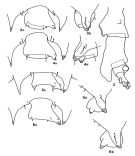 issued from : G.D. Grice & T.J. Lawson in Vie Milieu, 1977 (1978), 27 (2), Ser.A. [p.270, Pl.V]. Female: : 2, urosome (left lateral side). Male: 3A-6A, posterior end of 5th thoracic segment and genital somite of four specimens, dorsal); 3B-6B, idem (lateral view).
|
 issued from : G.O. Sars in An Account of the Crustacea of Norway. Vol. IV. Copepoda Calanoida. Published by the Bergen Museum, 1903. [Pl.XCI]. Female & Male. Nota: C: forehead; mp1 + mp2 (= Mx2 + Mxp).
|
 issued from : C. Razouls in Th. Doc. Etat Fac. Sc. Paris VI, 1972, Annexe. [Fig.54, B, B', C]. Male: B-B', P5 (from two specimens); C, urosome (dorsal).
|
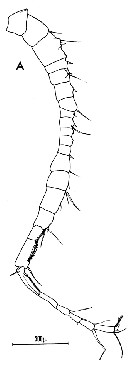 issued from : C. Razouls in Th. Doc. Etat Fac. Sc. Paris VI, 1972, Annexe. [Fig.55, A]. Male (from Banyuls): A, right A1.
|
 issued from : C. Razouls in Th. Doc. Etat Fac. Sc. Paris VI, 1972, Annexe. [Fig.53, A-C]. Female (from Banyuls, G. of Lion): A-C, P5 (from different specimens).
|
 issued from : G. Harding in Key to the adullt pelagic calanoid copepods found over the continental shelf of the Canadian Atlantic coast. Bedford Inst. Oceanogr., Dartmouth, Nova Scotia, 2004. [p.27]. Female & Male.
|
 issued from : S.B. Schnack in Crustacean Issue, 1989, 6. [p.143, Fig.6: 14]. 14, Candacia armata (from off NW Africa, upwelling region): Cutting edge of Md.
|
 issued from : R.-M. Barthélémy in Thèse Doct. Univ. Provence (Aix-Marseille I), 1999. [Fig.12, A]. Female (from Gulf of Marseille, NW Mediterranean Sea): A, external ventral view genital double-somite. go = genital operculum. Note the simple operculum covering genital area. Scale bar: 0.050 mm.
|
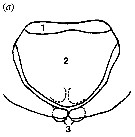 issued from : R.-M. Barthélémy, C. Cuoc, D. Defaye, M. Brunet & J. Mazza in Phil. Trans. R. Soc. Lond., B, 1998, 353. [p.729, Fig.54 a]. a, Schematic external genital area Candacia armata. Nota: Compare with C. simplex, C. bispinosa and C. ethiopica. Homologous structures have the same number: 1, anterior thickening of genital operculum; 2, median part of genital operculum; 3, posterior pad.
|
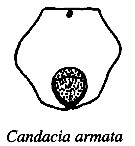 issued from : R.-M. Barthélémy, C. Cuoc, D. Defaye, M. Brunet & J. Mazza in Phil. Trans. R. Soc. Lond., B, 1998, 353. [p.733, Fig.63]. Schematic representation of external genital area in the species studied; Dashed line, limit of the anterior pad and lateral thickenings; shading, posterior pad; dots, genital operculum.
|
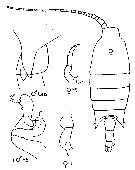 Issued from : J.M. Bradford-Grieve, E.L. Markhaseva, C.E.F. Rocha & B. Abiahy in South Atlantic Zooplankton, edit. D. Boltovskoy. 1999, Vol. 2, Copepoda; [p.1064, Fig. 7.361: Candacia armata ]. Ur = urosome; Gns = genital segment; r = right leg. Female characteristics (from key, p.956) : In dorsal view, protrusion on ventral surface of urosomal segment 2 visible on right side of somite, in dorsal view, lateral margins of genital segment with knob-like protrusions; apex of P5 ends in long saber-like point. - In dorsal view, lateral margins of genital segment not pointed. Urosomal segment 2 with ventral protrusion. - Posterior corners of prosome pointed.
Male characteristics (from key, p.956) : - In lateral view, right posterior prosome corner reaching posterior border of genital segment and turned slightly downwards. - Tip of 'thumb' of chela on right P5 reaching to about midlength of 'finger'. - In lateral view, distal end of right posterior corner of prosome not truncate, may or may not extend beyond posterior border of genital segment. - Right A1with segments 19 and 20 fused or partially fused or separate. - Right A1 with segments 17 and 18 separate. - Right A1 with segments 2 and 3 fused. - In dorsal view, genital segment with process. - Left posterior corner of the prosome pointed.
|
 Issued from : W. Giesbrecht in Fauna Flora Golf. Neapel, 1892, 19. [Taf. 39, figs. 1, 21, 24]. As Candacia pectinata. Female: 1, habitus (dorsal); 21, Thoracic segment 5 and abdominal segments 1 and 2 (lateral); 24, urosome (ventral).
|
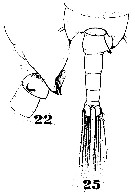 Issued from : W. Giesbrecht in Fauna Flora Golf. Neapel, 1892, 19. [Taf. 39, figs. 22, 25]. Male: 22, Thoracic segment 5 and abdominal segments 1 and 2 (lateral); 25, thoracic segment 5 and urosome (dorsal)..
| | | | | Compl. Ref.: | | | Pearson, 1906 (p.29); Rose, 1925 (p.152); Wilson, 1932 (p.22); 1942 a (p.174); Massuti Alzamora, 1942 (p.95, Rem;); Sewell, 1948 (p.463, 467, 468, 506); C.B. Wilson, 1950 (p.180); Fleury, 1950 (p.47, fig.2); Østvedt, 1955 (p.15: Table 3, p.76); Deevey, 1956 (p.127, tab. IV); 1960 (tab.II); ? Yamazi, 1958 (p.151, Rem.); Deevey, 1960 (p.5, Table II, annual abundance); Wickstead, 1962 (p.546, food & feeding); Grice & Hart, 1962 (p.287, table 4: abundance); Gaudy, 1962 (p.93, 99, Rem.: p.112) ; Duran, 1963 (p.23); Giron-Reguer, 1963 (p.36); Shmeleva, 1963 (p.141); Grice, 1963 a (p.496); Bary, 1963 a (p.1519, Table 1); Mazza, 1964 (p.293, weight); Shmeleva, 1965 b (p.1350, lengths-volume -weight relation); Pavlova, 1966 (p.44); Mazza, 1966 (p.72); 1967 (p.364, 377); Ehrhardt, 1967 (p.741, geographic distribution, Rem.); Vinogradov, 1968 (1970) (p.268); Shih & al., 1971 (p.37); Bainbridge & Forsyth, 1972 (p.21, Table I: indictor species, Table II: correlation analysis, Pl. XiV: seasonal abundance); Lefèvre-Lehoërff, 1972 (p.1681); Razouls S., 1972 b (p.2, respiration); Apostolopoulou, 1972 (p.328, 366); Nival & al., 1974 (p.231, respiration & excretion); S. Razouls, 1974 (147, oxygen rate); Vives & al., 1975 (p.52, tab.II, III); Colebrook, 1978 (tab.1); Vaissière & Séguin, 1980 (p.23, tab.1); Pipe & Coombs, 1980 (p.223, Table II, vertical occurrence); Vives, 1982 (p.294); Kovalev & Shmeleva, 1982 (p.85); Turner & Dagg, 1983 (p.16); Tremblay & Anderson, 1984 (p.4); Sameoto, 1984 (p.767, vertical migration); Scotto di Carlo & al., 1984 (1045); Brenning, 1985 a (p.28, Table 2, fig.9); Regner, 1985 (p.11, Rem.: p.37); Jansa, 1985 (p.108, Tabl.I, , II, III, IV, V); Williams & Collins, 1985 (p.28); Petipa & Borichenko, 1985 (tab.2); Brylinski, 1986 (p.457, spatial variations); Brenning, 1987 (p.27, spatial distribution, T-S diagram, Rem.); Gorsky & al., 1988 (p.133, Table I, C-N composition); Lozano Soldevilla & al., 1988 (p.60); McLaren & al., 1989 (p.560, life history, annual production); Citarella, 1989 (p.123, abundance); Fransz & al., 1991 (p.8); Seguin & al., 1993 (p.23); Kouwenberg, 1993 a (p.281, fig.4, sex ratio); Hays & al., 1994 (tab.1); Kouwenberg, 1994 (p.69, tab.1); Shih & Young, 1995 (p.68); Krause & al., 1995 (p.81, Fig.14, abundance, Rem.: p.131); Fernandez de Puelles & al., 1996 (p.97, occurrence: p.101); Falkenhaug & al., 1997 (p.449, spatio-temporal pattern); Hure & Krsinic, 1998 (p.102); Mauchline, 1998 (tab.47); Reid & Hunt, 1998 (p.310, figs.2, 3, Rem.); Gilabert & Moreno, 1998 (tab.1, 2); Corten, 1999 (p.191, fig.3, Table 1, 2); Siokou-Frangou, 1999 (p.478); Lapernat, 2000 (tabl.3, 4); Seridji & Hafferssas, 2000 (tab.1); Plounevez & Champalbert, 2000 (p.175, Table III, IV, V, abundance vs fish, Rem.: p.185); d'Elbée, 2001 (tabl. 1); Holmes, 2001 (p.29, Rem.); Fransz & Gonzalez, 2001 (p.255, tab.1); Beaugrand & al., 2002 (p.1692); Beaugrand & al., 2002 (p.179, figs.5, 6); Daly Yahia & al., 2004 (p.366, fig.4); Bonnet & Frid, 2004 (p.485, fig.5); CPR, 2004 (p.51, fig.143); Lopez-Urrutia & al., 2004 (p.303, clearance rate, predation); Queiroga & al., 2005 (p.195, table 1); Isari & al., 2006 (p.241, tab.II); Valdés & al., 2007 (p.104: tab.1); Khelifi-Touhami & al., 2007 (p.327, Table 1); Cabal & al., 2008 (289, Table 1); Gaard & al., 2008 (p.59, Table 1, N Mid-Atlantic Ridge); Brylinski, 2009 (p.253: Tab.1, p.255:Rem.); Escribano & al., 2009 (p.1083, fig.6: N Chile); Mazzocchi & Di Capua, 2010 (p.424); Eloire & al., 2010 (p.657, Table II, temporal variability); Dvoretsky & Dvoretsky, 2010 (p.991, Table 2); S.C. Marques & al., 2011 (p.59, Table 1); Fileman & al., 2011 (p.403, abundance vs bloom condition); Isari & al., 2011 (p.51, Table 2, abundance vs distribution); Van Ginderdeuren & al., 2012 (p.3, Table 1); Salah S. & al., 2012 (p.155, Tableau 1); McGinty & al., 2012 (p.122, time series abundance); Bode & al., 2012 (p.108, spatial distribution vs time-series, % biomass); Alvarez-Fernandez & al., 2012 (p.21, Rem.: Table 1); Belmonte & al., 2013 (p.222, Table 2, abundance vs stations); Sobrinho-Gonçalves & al., 2013 (p.713, Table 2, fig.8, seasonal abundance vs environmental conditions); Kürten & al., 2013 (p.167, Table 1, C:N, fatty acid); Lidvanov & al., 2013 (p.290, Table 2, % composition); Benedetti & al., 2016 (p.159, Table I, fig.1, functional characters); Ben Ltaief & al., 2017 (p.1, Table III, Summer relative abundance); El Arraj & al., 2017 (p.272, table 2, spatial distribution); Belmonte, 2018 (p.273, Table I: Italian zones); Chaouadi & Hafferssas, 2018 (p.913, Table II: occurrence). | | | | NZ: | 6 + 6 doubtful | | |
|
Distribution map of Candacia armata by geographical zones
|
| | | | | | | | | | | | | | |  Chart of 1996 Chart of 1996 | |
 issued from : A.A. Shmeleva in Bull. Inst. Oceanogr., Monaco, 1965, 65 (n°1351). [Table 6: 34 ]. Candacia armata (from South Adriatic). issued from : A.A. Shmeleva in Bull. Inst. Oceanogr., Monaco, 1965, 65 (n°1351). [Table 6: 34 ]. Candacia armata (from South Adriatic).
Dimensions, volume and Weight wet. Means for 50-60 specimens. Volume and weight calculated by geometrical method. Assumed that the specific gravity of the Copepod body is equal to 1, then the volume will correspond to the weight. |
 issued from : U. Brenning in Wiss. Z. Wilhelm-Pieck-Univ. Rostock - 36. Jahrgang 1987. Mat.-nat. wiss. Reihe, 2. [p.27, Fig.1]. issued from : U. Brenning in Wiss. Z. Wilhelm-Pieck-Univ. Rostock - 36. Jahrgang 1987. Mat.-nat. wiss. Reihe, 2. [p.27, Fig.1].
Spatial distribution for Candacia curta, C. armata, C. bipinnata, C. paenelongimana, C. varicans (as varians), C. pachydactyla, C. longimana, C. ethiopica, Paracandacia simplex ( = C. simplex) from 8° S - 26° N; 16°- 20° W, for different expeditions (V1: Dec. 1972- Jan. 1973; V2: Feb/Mar. 1973; VI: May 1974; IV: Jun./Jul. 1972). |
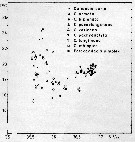 issued from : U. Brenning in Wiss. Z. Wilhelm-Pieck-Univ. Rostock - 36. Jahrgang 1987. Mat.-nat. wiss. Reihe, 2. [p.28, Fig.2]. issued from : U. Brenning in Wiss. Z. Wilhelm-Pieck-Univ. Rostock - 36. Jahrgang 1987. Mat.-nat. wiss. Reihe, 2. [p.28, Fig.2].
T-S Diagram for Candacia curta, C. armata, C. bipinnata, C. paenelongimana, C. varicans, C. pachydactyla, C. longimana, C. ethiopica, Paracandacia simplex ( = C. simplex) from 8° S - 26° N; 16°- 20° W. |
 Issued from : M. Krause, J.W. Dippner & J. Beil in Prog. Oceanog., 1995, 35. [p.101, Fig.14]. Issued from : M. Krause, J.W. Dippner & J. Beil in Prog. Oceanog., 1995, 35. [p.101, Fig.14].
Horizontal distribution pattern of Candacia armata (individuals per m2) in the winter North Sea.
Collected by WP2-net. Numbers (ind/m3) depth-integrated, extrapoled to the bottom (but at a maximum to a depth of 500 m) and expressed as ind per m2 of water surface. |
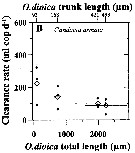 Issued from : A. Lopez-Urrutia, R.P. Harris & T. Smith in Limnol. Oceanogr., 2004, 49 (1). [p.305, Fig.3]. Issued from : A. Lopez-Urrutia, R.P. Harris & T. Smith in Limnol. Oceanogr., 2004, 49 (1). [p.305, Fig.3].
Clearance rate of (B) Candacia armata from off Plymouth (English Channel), in relation to the size of Oikopleura dioica (Appendicularians).
The first x-axis data points represent the diameter of O. dioica eggs. Solid symbols represent the measured clearance rates and open symbols represent their mean. Vertical and horizontal error bars are the standard deviation of clearance rates and O. dioica size, respectively.
O. dioica cultures were maintened and experiments conducted in a constant temperature room at 15°C with a simulated 12:12 day: night cycle. Cohorts of cultured O. dioica , maintened according to Fenaux and Gorsky, 1985, were used to obtain eggs and juvenile appendicularians. |
 Issued from S. Razouls in XXIII rd Congress of Athens, 3-11 November 1972. [p.2]. Oxygen consumed by individual (adult) in the Banyuls Bay and equivalent carbon asked. Issued from S. Razouls in XXIII rd Congress of Athens, 3-11 November 1972. [p.2]. Oxygen consumed by individual (adult) in the Banyuls Bay and equivalent carbon asked.
(1) Hydrological season in the stability period: Eté = Summer: 18-20 °C; Hiver = Winter: 13-10°C.
Espèces = species; Saison = Season; Lg céph.= cephalothoracic length; an = individual. |
| | | | Loc: | | | [South Africa (SE & SW), Namibia], Canary Is., off Mauritania, off Morocco-Mauritania, Cap Ghir, off Madeira, Portugal, Azores, Florida, Chesapeake Bay, G. of Maine, Long Island, Delaware Bay, off Woods Hole, Bay of Fundy, Emerald Bank, off SE Nova Scotia, Northumberland Strait, G. of St. Lawrence, off E Newfoundland, Faroe Is., Wyville Thomson Ridge, Norway Sea, Norway, Barents Sea, North Sea, NE Scotland, off SW Ireland, Galway Bay, Bristol Channel, Ireland, Bay of Biscay, Portugal (Mondego estuary), NW Spain (Arosa, Coruña, Santander), English Channel, Morlaix estuary, Pas de Calais, Ibero-moroccan Bay, Medit. (Alboran Sea, Habibas Is., Algiers, El Kala, Castellon, Baleares, Banyuls, Marseille, Villefranche-s-Mer, Ligurian Sea, Tyrrhenian Sea, Strait of Messina, Taranto, Adriatic Sea, Ionian Sea, Aegean Sea, Thracian Sea, Lebanon Basin), ? Red Sea: Aqaba (in Vaissière & Séguin, 1984), [? SE Indian , sub-equatorial], [ ? SE Australia], Sulu Sea, Philippines, China Seas (East China Sea), Nagazaki, off E Japan, Hawaii, ? off California, W Baja California, Central America , W Equador, N Chile, off Is. Bering Is.]; The localisations for Philippines and the Pacific in C.B. Wilson, 1942 a; 1950 and Kott, 1957 (SE Australia); for the Indian Ocean in Chiba & al., 1957 a; for the South Africa: De Decker, 1964, but cancelled in 1984 (p.317) | | | | N: | 160 (Arct.: 3, N Atlant.: 88; Medit.: 63; ? Red Sea: 1; ? Indian: 3, ? Pacif.: 4) | | | | Lg.: | | | (38) F: 2,64-2,4; M: 2,54-2,48; (45) F: 2,75-2,5; M: 2,6-2,25; (46) F: 2,4-1,95; M: 2,12-1,7; (65) F: 2,7; M: ± 2,7; (342) F: 2,554-2,174; M: 2,402-2,021; (344) F: 2,88-2,3; M: 2,4-2,2; (449) F: 2,7-1,95; M: 2,7-1,7; (920) F: 2,51; M: 2,10-2,12; (1110) F: 2,3-3,19; M: 2,3-1,66; {F: 1,95-3,19; M: 1,70-2,70} | | | | Rem.: | epi-mesopelagic. In surface after Pearson (1906, p.29) at Valentia Island and Cleggan (Ireland). 10-420 m (Pipe & Coombs, 1980 at 60°N, 07°W).
No account has been taken of the localities between brackets in the table of synthesis. May be confused with C. giesbrechti notably in the Mediterranean Sea.
The locality records established by C.B. Wilson (1950, p.180: stations of the west coasts of Mexico and Central America) would be erroneous (Fleminger & Bowman, 1956, p.332).
The records from the eastern Chinese Sea (in Shih & Young, 1995) and in Japan ( Tanabe Bay by Yamazi, 1958, and Nagazaki by Anraku & Azeta, 1965) are to be confirmed.
Species regarded as an indicator of water of Atlantic origin in the North Sea.
After S.B. Schnack (1989) the Itoh's index value of mandibular gnathobase = 1879. | | | Last update : 25/10/2022 | |
|
|
 Any use of this site for a publication will be mentioned with the following reference : Any use of this site for a publication will be mentioned with the following reference :
Razouls C., Desreumaux N., Kouwenberg J. and de Bovée F., 2005-2025. - Biodiversity of Marine Planktonic Copepods (morphology, geographical distribution and biological data). Sorbonne University, CNRS. Available at http://copepodes.obs-banyuls.fr/en [Accessed August 29, 2025] © copyright 2005-2025 Sorbonne University, CNRS
|
|
 |
 |




















